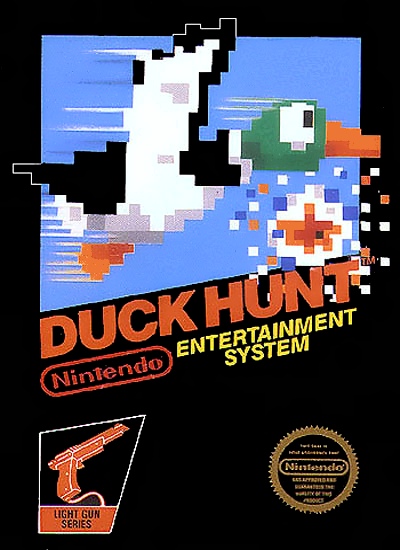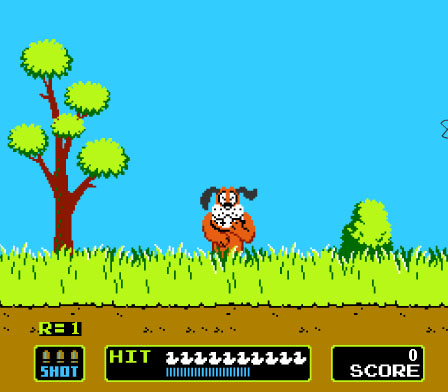
It's official: today's video games are way too realistic. The other day I foolishly opted to play some Big Buck Hunter at a local bar, leading to my inevitable cowering at the prospect of repeatedly killing deer that bore ab eerie resemblance to Bambi's mom. What happened to the days of blurrily pixelated hunting? I don't think I could ever shoot a real live deer in the face, yet I'm more than gleeful for a shot (pun intended) at some Duck Hunt mallards or lethargic bison in Oregon Trail. What? I don't want that dog to mock my haul, nor do I want to face the embarrassment of having caught so few pounds of meat that it actually fits in my covered wagon. It's a legitimate justification.
With a sufficient proportion of pixelated non-realism coupled with a totally fake looking red plastic gun, even the most squeamish shooters among us were wont to take out an entire flock in a single round. Old school Nintendo knew a thing or two (in retrospect, I'd say two) about the notion of less is more. The game was incredibly repetitive, requiring us only to shoot at a duck or two per round and to avoid shooting the dog. It may not have held the attention of today's overstimulated child, but many children of the 80s and 90s lost great stretches of time--not to mention the ability to focus our eyes--to this simple electronic endeavor.
In comparison to the shooting games available on today's video game market, Duck Hunt was incredibly tame. Our duck victims never bled profusely from their gaping wounds nor did they ever shake a mangled wing at us while accusing us of poultricide. In fact, we had almost no interaction with them at all. They simply flew overhead to the mesmerizingly hypnotic music, we shot at them, and our loyal canine companion retrieved their abandoned carcasses. No fuss, no muss.
Of course, it wasn't all invisible off-screen blood and guts as we appraised our killing streak. We also had a chance to shoot skeet, which thankfully had no R-rated double meaning to us at the time. The eruptions of clay pigeons in the air was not especially differentiated from the hunting of live ducks, thanks to the primitive mid-80s gaming graphics technology. Whether the bullet contact induced an exploding gray circle or an exploding purple and white circle with wings, it all sort of blended into a generally gore-free exercise.
That dog, though, could have used some serious etiquette training. In fact, many bootleg versions of the game enable the player to shoot and kill the dog, fulfilling the fantasy many of us constructed after enduring his endless merciless taunts at our shoddy aim. You shoot, you miss, the dog mocks you profusely. It was more than enough to grate on our fragile young egos. Plus, he was incredibly annoying. I admit to aiming the gun at him once or twice, but unfortunately in the official game, there's just no getting rid of him.

No matter how easily amused we claim we may have been as children, there's no true justification for having played this game for more than 20 minutes at a time. It is so utterly mindless, prolonged playing may begin melting the softer areas of your brain. There is, indeed, an object to the game: shoot anything that moves; however, that's not quite enough of a motivating premise to keep us engaged for hours a la Super Mario Brothers or Tetris.
Duck Hunt's popularity can be credited to its bundling with the Super Mario Brothers game, both of which came with the classic Nintendo Entertainment System. While Duck Hunt probably couldn't stand alone as a bestselling game, it enjoyed widespread de facto popularity for one reason: because it was there. The plastic gun was still a bit of a novelty for an at-home gaming system, so it didn't matter much to us that the game was a simple exercise in point and shoot. We point, we shot, we outsmarted that damn dog.
It certainly didn't attain the same cult following as its bundle-mate Super Mario Brothers, but Duck Hunt achieved a quiet iconic status by default. Whether or not you were a fan of the game, if you owned an NES, you probably owned Duck Hunt. I still can't see that little red plastic gun without itching to take out some 8-bit fowl. I may not have ever developed the killer instinct, but this family friendly take on a shooting game made the genre palatable to even the wussiest of young gamers. See, sensitive kids can kill things, too! Thanks, Nintendo.






